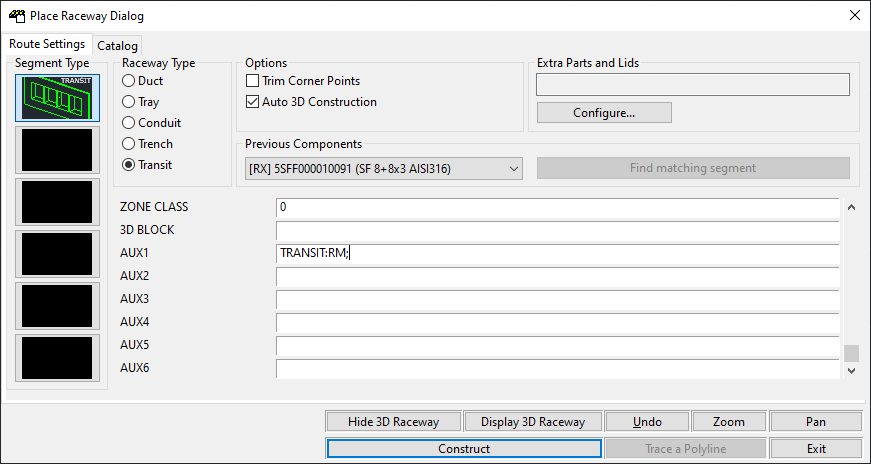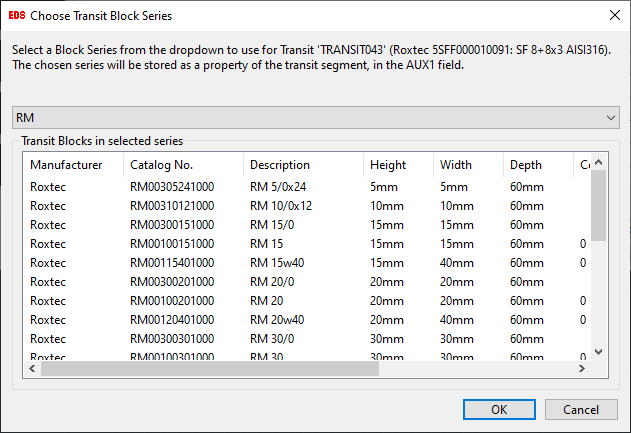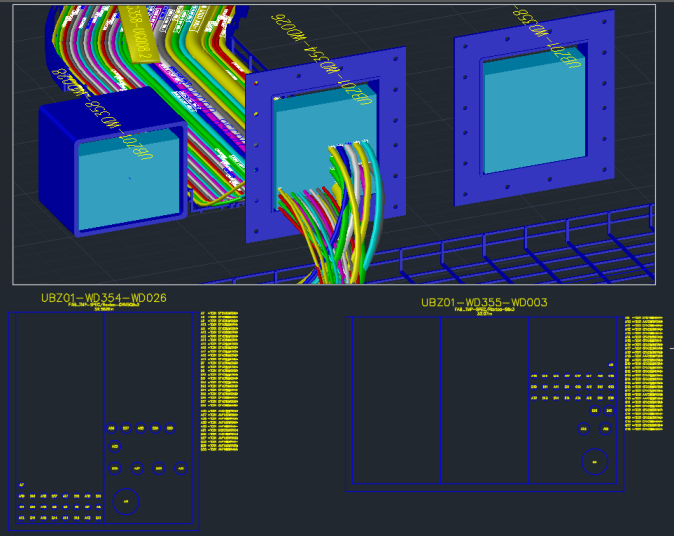Transits
Introduction
Transits are raceway components used to provide sealed penetrations though walls, bulkheads, and cabinets, where several cables must enter, but penetrants such as water, air, gas, or fire must not.
Paneldes supports transits as a type of raceway segment, and includes catalogs containing supported components (transit frames, blocks, etc) from the Roxtec and Hilti transit systems.
Frames and Openings
The frame is the main structural component of a transit. A transit frame can contain one or more openings, which are designed to be filled with sealing blocks/modules, and optionally stay-plates and compression modules.
The photo below shows a Roxtec rectangular transit frame with three rectangular openings across the frame, each filled with 5 rows of sealing blocks/modules, 5 stay plates, and a single compression module:

Sealing Blocks
Transits use a series of rubber blocks (also known as modules) which are clamped around cables to form a pressure tight seal around the cable and against adjacent blocks. Each size of rubber block is adjustable to fit a range of cable sizes (diameters) within it.
The rubber blocks are sized to fit modularly and regularly in a frame opening. For example, 4 x 30mm or 6 x 20mm blocks would fit across a 120mm wide opening with no gaps.
Depending on the type of transit frame, the rubber blocks are compressed to form a complete seal either by a screw tight compression wedge module inserted at the top of an opening, or screw tight compression integrated into the frame itself.
The photo below shows a Roxtec transit sealing block:

Inserting a Transit
Follow the Place Raceway procedure, choosing Transit as the Raceway Type.
Note:
Paneldes supports rectangular frames with multiple rows and columns of rectangular openings.
Paneldes supports circular frames with a single rectangular opening.
Use the Catalog tab to quickly choose a transit frame from the Roxtec, Hilti, or any other suitable manufacturer catalog.
If the BLOCK3D field is populated, Paneldes will insert the specified CAD block as the graphical representation of the transit. Otherwise, Paneldes will construct a parametrically defined graphical representation of the transit (that approximates the real part), based on its frame dimensions.
Specifying Power per Opening
Transits support a single power number (or range) just like other undivided raceway segment types. In this case, the number (or range) will be applied to all openings of the transit.
Transits also support split power, where the total width of all the openings in the frame is considered the "tray width", and splits (by proportion or by absolute width) will be rounded (if necessary) to coincide with a multiple of the opening width. This allows different openings to have a different power number/range (but prohibits power splitting within any single opening).
For example, for a transit with 4 frames in a single row, the POWER value of "1,2",N0.25,"3,4",0.5,"5,6" would cause the first opening to have a power string of "1,2", the second and third openings to have "3,4" and the last opening to have "5,6".
Note: Power splits are applied to openings left-to-right, starting with the bottom row of openings, when looking at the transit from first end (the end of the transit without the short align line).
Specifying a Sealing Block Series
Transits require a series of sealing blocks to be specified. The cable routing procedure will use sealing blocks from the specified series to accurately model the transit opening based on the cables that are routed (or being tested to route) through it. This ensures that every cable that goes through an opening does so in a suitable sealing block, and that the arrangement of all blocks has no gaps, and does not exceed the packing space of the opening.
The sealing block series name must be set as the value of the TRANSIT property in the AUX1 field during transit insertion (on the Place Raceway dialog). For example:

If a series name is not specified on the insertion dialog (or the specified series does not exist or is invalid), the following dialog will be shown, allowing you to choose the desired series from all available series, and preview the blocks in the series:

After insertion, the series name can be modified in Global Editor, by editing the AUX1 field.
If the manufacturer defined series specified in the catalogs does not fit your needs (for example, if you do not wish to use certain blocks in a series), you can create a user-defined series containing only the desired sealing blocks. All user-defined series will be automatically included in the dropdown on the Choose Series dialog shown above.
Transit Filling
Like other raceway segment types, transits are subject to filling checks when performing cable routing. However, for transits, these filling checks are performed per opening, and in terms of populated sealing block area vs available packing area (in contrast to other segment types, which use cable factor and weight factor).
The transit filling algorithm will generate an arrangement of sealing blocks (chosen from those that belong to the specified series for the transit) that:
- Ensures each cable is sealed by a sealing block that has a compatible cable diameter range,
- Minimizes the packing area occupied by populated sealing blocks (that is, those that are sealing one or more cables),
- Ensures any packing area not filled by populated sealing blocks can be filled by unpopulated sealing blocks (or solid compensation blocks) without leaving any gaps.
A cable being routed may be routed through any opening of a transit, provided the filling algorithm can generate a valid arrangement if the cable is included, and provided other routing checks pass (such as power compatibility).
A locked cable will remain in the same opening of a transit, unless the original frame has become unsuitable (no valid filling arrangement, or incompatible power), in which case the locked cable will be moved to another suitable opening (one that allows for a valid filling arrangement, and compatible power). If the transit has no suitable openings remaining for a locked cable, the cable will report a relevant filling or power warning.
Fill Visualisation
Paneldes includes multiple methods to visualize and check the fill and cable arrangement of transits after performing cable routing. You can:
View routed cables in CAD to see cables passing through transits in 3D.
To view transit frames with or without the openings filled, toggle the visibility of the TRANSIT_Sealing and TRANSIT_Compression layers in CAD.Draw a 2D cross section of a transit in CAD (this can be produced in model-space or a paper-space layout, and includes various layout options).
Review the Transit Report text file to see the arrangement of cables (and sealing blocks) for all transits in textual form.
Note: Cable positioning within a transit opening may change if additional cable routing occurs.
The image below shows a paper-space layout with a viewport into model-space at the top (showing three transits that use custom BLOCK3D graphics), and two cross section diagrams at the bottom (the left-hand cross section was automatically created from the center transit in the model-space viewport):

Transit Report
After routing and filling, a transit report (<prj>TransitList.txt) is produced showing the arrangement of cables (and sealing blocks) for all openings of all transits. This provides an automated and detailed transit filling plan.
Information provided per opening includes:
- Transit name
- Opening number
- Opening packing size
- Cable names, sizes, and arrangement
- Sealing block series, part numbers, sizes, and arrangement
- Computed fill percentage
- Warnings (if applicable)
The transit report also includes summary BOM information:
- Counts of filled and unfilled sealing blocks by part number
- Counts of solid compensation blocks by part number
- Counts of frames by part number
